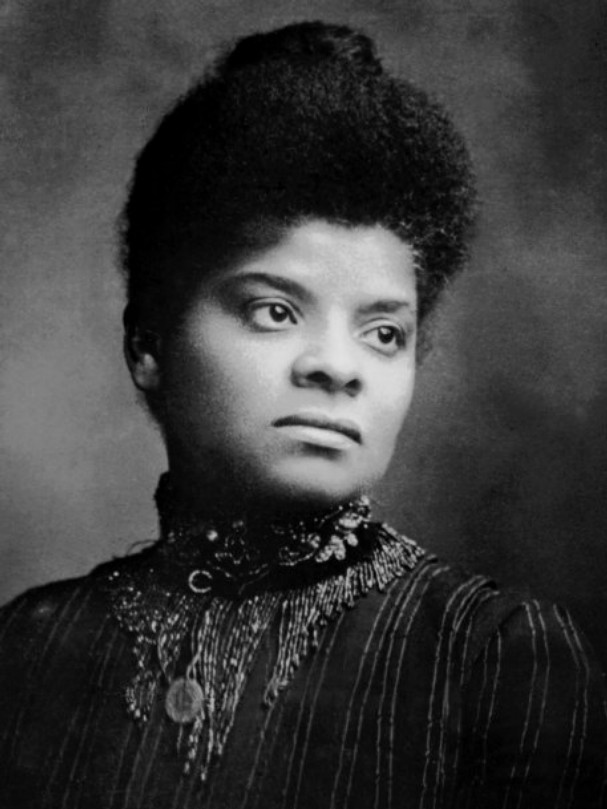
Ida B. Wells-Barnett
In times like these – and I don’t think I need to explain that phrase; you know what I mean – there is a lot of angst about how to move forward. Certainly, political change is necessary and political change can really only happen through compromise, by building coalitions around points of agreement and choosing to ignore points of disagreement. I know this. It is not my instinct, but I know it. Perhaps that is why I gravitate toward people like Ida B. Wells-Barnett. Somewhere alongside that compromise and coalition-building, we need people who speak prophetically: naming evil for what it is, pronouncing judgment upon it, and calling for repentance. Ida B. Wells-Barnett was a prophet of her age because she had the moral clarity and the courage to speak out against the evils of her day.
Ida was born in enslavement to parents who were enslaved. It was 1862, six months before the Emancipation Proclamation and three years before the ratification of the Thirteenth Amendment would officially make slavery illegal. Reconstruction, not surprisingly, brought continued conflict in the South, but in Ida’s hometown of Holly Springs, Mississippi, there seemed to be a more congenial approach. Shaw University (later Rust University) was established in 1866 for the education of freed slaves with wide support from the town’s citizens, both black and white. Ida’s father, who was a skilled carpenter and did well rebuilding the town after the Civil War, sat on the board of Shaw. He made sure that Ida was well-educated in literature, history, and Scripture. So, while Ida was born in terrible circumstances, her early experience of life was relatively free of the kind of racial strife seen elsewhere. She grew up with the assumption that she should be treated with dignity and respect, as should everyone else. Unfortunately, disease takes its measure of equality by attacking everyone.
Yellow fever broke out in Holly Springs in 1878, taking her parents and her youngest sibling. She was determined to keep the family together, so at the age of sixteen she became the head of a household of five. She had completed enough coursework at Shaw to qualify as a teacher, so with the help of her grandmother and friends, she worked during the week at a country elementary school for black children. After a couple of years, she found that she could make more money teaching at a city school, so she moved to Memphis. On her way there, she experienced a defining moment.
She bought a first class ticket on the train and expected to sit in a first class car. When the conductor came around taking tickets, he said he couldn’t take hers, so she stayed in her seat. When he came back around, he told her she couldn’t sit there and tried to forcibly remove her. He got bitten for his efforts. When they reached the next stop, a porter helped him remove her and she decided not to reboard to the smokers’ car where they wanted her to sit. She sued the railroad and won $500, but it was reversed on appeal. She was crushed: “I have firmly believed all along that the law was on our side and would, when we appealed to it, give us justice. I feel shorn of that belief and utterly discouraged, and just now, if it were possible, would gather my race in my arms and fly away with them.” This would not be the last time she felt this way, but, fortunately, she did not fly away, but stayed to fight.
Her teaching career in Memphis morphed into newsletter editor and, ultimately, owner of a press. She began her editorial career with an account of her suit against the railroad and then followed it up with a scathing critique of segregated education, including accusations of sexual impropriety between the white school board and the young black teachers they hired. She named names. She put racists on blast.
Her first writing on lynchings came in 1891 when her friend, informant, and mail carrier, Thomas Moss was lynched by an angry mob. Moss, along with two partners, had established a new grocery store, the People’s Grocery Company, in a predominantly black neighborhood of Memphis known as the Curve. Prior to that, a white-owned grocery enjoyed a cozy monopoly in the Curve. Racial tensions were heightened when a marble game between black and white children turned violent. The white children and their parents were always the attackers and always lost, so they were looking to soothe their sore egos with vengeance. They announced publicly that they would attack the People’s Grocery, but the police would not help defend the black-owned business. Moss and his partners armed themselves and, sure enough, three white men got shot trying to loot the grocery. More than a hundred black men were arrested and white men were allowed into the jail to make accusations as they pleased. The white papers encouraged white men to take action and they did. On the third night of their incarceration, after it was revealed that the white wounded would recover and the black community thought the trouble was over, Thomas Moss and his two partners in the People’s Grocery were dragged from the jail, loaded on a train, and shot outside the city limits.
Black men gathered near the People’s Grocery to register their discontent. A judge ordered the sheriff to organize a hundred armed men to shoot on sight any black people who appeared to be causing trouble. The black men understood the danger and dispersed, so the mob looted the store and had its creditors seize any surviving assets. The People’s Grocery was no more.
In the wake of this, nearly 6000 black people left Memphis; more boycotted white businesses. When the white businesses in Memphis realized how much money they were losing, they begged Ida to publish an editorial encouraging black people to continue business as usual, to assure them that they were safe. She refused and published an account of their supplications in her paper. Soon after, while at a church denominational meeting in Philadelphia, white business owners destroyed her press and left a note telling her she would be killed if she returned to Memphis. She did not return, but she also did not stop writing.
Ida began to investigate and document every lynching that came to her attention. In the white press, they were always justified, usually by saying that a black man had raped a white woman. Somehow, when the white women were left alone during the Civil War, black men did not dare such a thing. Now, twenty-five years later, in the early years of the Lost Cause, there was an epidemic. When Ida investigated, she found two common themes in the facts. First, rape was never proven. Lynchings don’t have trials. More often, the facts seem to show that two people fell in love (or perhaps lust) across color lines and followed their passions. Whether the white woman involved made a false accusation or not, the result was the same. Second, lynchings were more likely to occur when black people were succeeding economically. It wasn’t necessary to target those who were successful; just let them know that white people are not bound by the law and can take your property and your life any time they wish.
I wish that I could say that Ida’s work influenced the nation and brought an end to lynchings, but we know that is not true. They continued into the 1960s. In fact, the last recognized lynching in America was in 1981 in Mobile, Alabama. I would argue that the rise in murders of trans women of color should be classified as lynching. Lynching is a terrorist act, designed to let a class of people know that they are outside the protection of the law. They are not intended to kill just one person, but to kill a community that is seeking equality.
Bryan Stevenson of the Equal Justice Initiative’s Lynching in America Project has said that reconciliation is not possible without truth. So far, we have refused to speak the truth about lynching because it would require us to recognize the underlying ideology of white supremacy that has never gone away, but only evolved from slavery to Jim Crow to mass incarceration. If it weren’t for the work of St. Ida B. Wells-Barnett, we would have no means of examining that truth. Now we only need the will.
